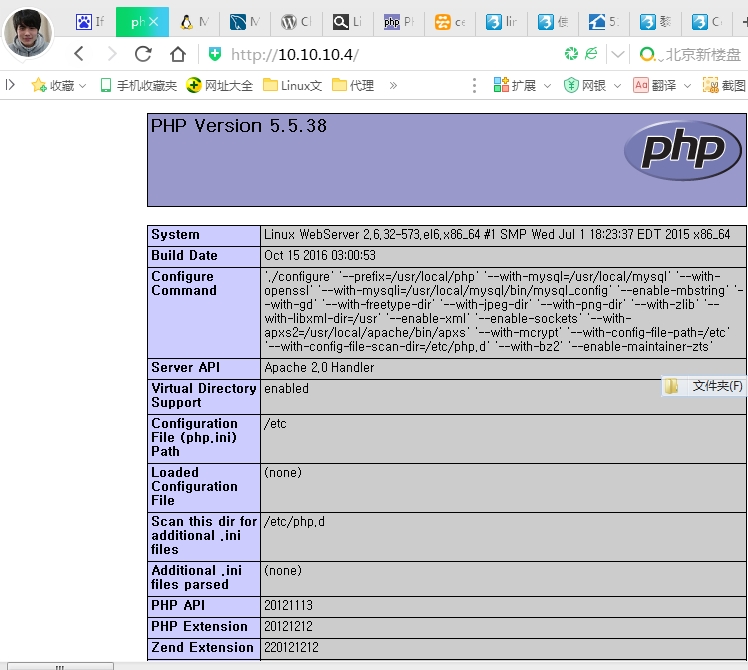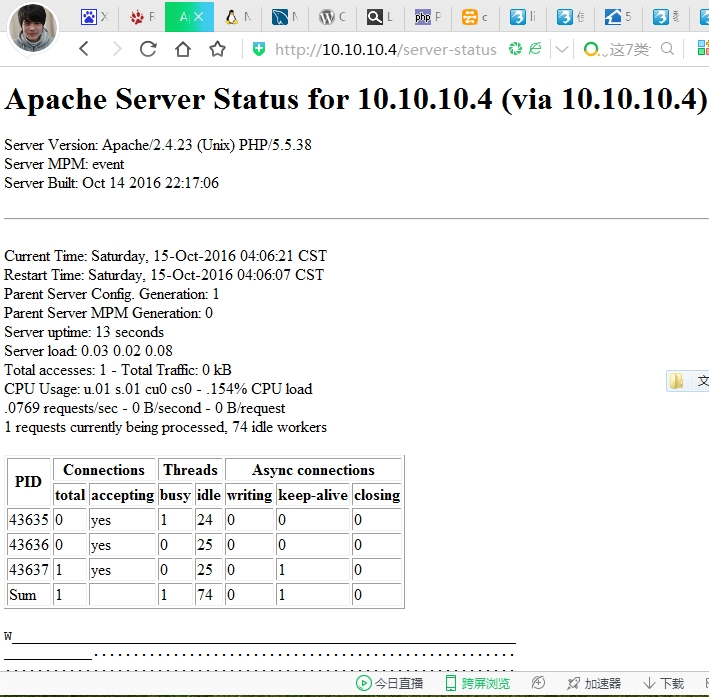编译安装LAMP环境:httpd-2.4+mysql5.6+php5.5
Posted
tags:
篇首语:本文由小常识网(cha138.com)小编为大家整理,主要介绍了编译安装LAMP环境:httpd-2.4+mysql5.6+php5.5相关的知识,希望对你有一定的参考价值。
本文大纲:
1、安装前准备
2、编译安装Apache
3、安装mysql数据库
4、编译安装php
5、配置httpd服务,使其支持php
6、安装Xcache加速器
7、启用服务器状态页面
8、PHP连接Mysql测试
所有软件包的网站下载地址:
apr和apr-util:http://apr.apache.org/
httpd:http://httpd.apache.org/
三条主线:2.0/2.2/2.4/
mysql:http://dev.mysql.com/downloads/mysql/
现在页面默认是5.7,也可以在页面里选择5.6/5.5的版本,源码安装选择最下面的Source Code,然后选择最下面的tar.gz的压缩包
libmcrypt和libmcrypt-devel:https://pkgs.org/
php:http://php.net/downloads.php
xcache:http://xcache.lighttpd.net
wordpress:https://cn.wordpress.org/
本文档中所有软件包集合下载地址:
https://pan.baidu.com/s/1pLpSy5l
1、安装前准备
修改yum源
[[email protected] ~]# wget -O /etc/yum.repos.d/CentOS-Base.repo [[email protected] ~]# vim /etc/yum.repos.d/CentOS-Base.repo # 在末行模式下执行%s/$releasever/6.8/g,6.8为6系列中最新的版本号,如果是CentOS6,不需要执行这一项 [[email protected] ~]# yum clean all [[email protected] ~]# yum makecache
卸载原有httpd-2.2
[[email protected] ~]# cp /etc/init.d/httpd /etc/init.d/httpd.bak # 备份这个文件后面做服务器脚本文件 [[email protected] ~]# yum remove httpd -y
安装编译工具
[[email protected] ~]# yum groupinstall -y "Development Tools" "Server Platform Development"
关闭SElinux
[[email protected] ~]# vim /etc/selinux/config SELINUX=disabled # 从新启动
关闭防火墙
[[email protected] ~]# /etc/init.d/iptables stop [[email protected] ~]# chkconfig iptables off [[email protected] ~]# chkconfig --list | grep iptables iptables 0:off 1:off 2:off 3:off 4:off 5:off 6:off
修改主机名
[[email protected] ~]# hostname WebServer [[email protected] ~]# vim /etc/sysconfig/network HOSTNAME=WebServer [[email protected] ~]# vim /etc/hosts 127.0.0.1 WebServer WebServer.wlm.com localhost4 localhost4.localdomain4 ::1 localhost localhost.localdomain localhost6 localhost6.localdomain6 从新启动
2、编译安装Apache
1)解决依赖关系
httpd-2.4.23需要较新版本的apr和apr-util,因此需要事先对其进行升级。升级方式有两种,一种是通过源代码编译安装,一种是直接升级rpm包。
(1)编译安装apr
[[email protected] ~]# cd apr-1.5.2 [[email protected] ~]# tar -zxvf apr-1.5.2.tar.gz [[email protected] ~]# ./configure --prefix=/usr/local/apr # 设置安装路径 [[email protected] ~]# make && make install
(2)编译安装apr-util
[[email protected] ~]# tar -zxvf apr-util-1.5.4.tar.gz [[email protected] ~]# cd apr-util-1.5.4 [[email protected] ~]# ./configure --prefix=/usr/local/apr-util --with-apr=/usr/local/apr # --prefix指定安装路径;--with-apr指定apr的安装路径,apr-util依赖于apr [[email protected] ~]# make && make install
(3)httpd-2.4.23编译过程也要依赖于pcre-devel软件包和openssl,需要事先安装。
[[email protected] ~]# yum install pcre-devel [[email protected] ~]# yum install openssl-devel -y
2)编译安装httpd-2.4.23
[[email protected] ~]# tar -zxvf httpd-2.4.23.tar.gz [[email protected] ~]# cd httpd-2.4.23 [[email protected] httpd-2.4.23]# ./configure --prefix=/usr/local/apache --sysconfdir=/etc/httpd --enable-so --enable-ssl --enable-cgi --enable-cgid --enable-modules=most --enable-mods-shared=most --enable-rewrite --with-zlib --with-pcre --with-apr=/usr/local/apr --with-apr-util=/usr/local/apr-util --enable-mpms-shared=all --with-mpm=event --sysconfdir=/etc/httpd :指定配置文件安装位置 --enable-so :支持动态共享模块如果没有这个模块PHP将无法与apache结合工作 --enable-ssl :启用支持ssl --enable-cgi :支持cgi --enable-rewrite :支持URL重写 --with-zlib :压缩库,在互联网上传播时可节约带宽 --with-apr=/usr/local/apr :指定apr路径 --with-apr-util=/usr/local/apr-util :指定apr-util路径 --enable-mpms-shared=all :支持多道处理模块 --with-mpm=event :设定默认的模块 [[email protected] httpd-2.4.23]# make && make install # 编译和安装
动态模块和静态模块的说明: (1)构建MPM为静态模块 在全部平台中,MPM都可以构建为静态模块。在构建时选择一种MPM,链接到服务器中。如果要改变MPM,必须重新构建。为了使用指定的MPM,请在执行configure脚本 时,使用参数 --with-mpm=NAME。NAME是指定的MPM名称。编译完成后,可以使用 httpd -l 来确定选择的MPM。 此命令会列出编译到服务器程序中的所有模块,包括 MPM。 (2)构建 MPM 为动态模块 在Unix或类似平台中,MPM可以构建为动态模块,与其它动态模块一样在运行时加载。 构建 MPM 为动态模块允许通过修改LoadModule指令内容来改变MPM,而不用重新构建服务器程序。在执行configure脚本时,使用--enable-mpms-shared选项即可启用此特性。当给出的参数为all时,所有此平台支持的MPM模块都会被安装。还可以在参数中给出模块列表。默认MPM,可以自动选择或者在执行configure脚本时通过--with-mpm选项来指定,然后出现在生成的服务器配置文件中。编辑LoadModule指令内容可以选择不同的MPM。
3)修改httpd的主配置文件,设置其Pid文件的路径
[[email protected] httpd-2.4.23]# cd /etc/httpd/ [[email protected] httpd]# cp httpd.conf httpd.conf.bak [[email protected] httpd]# vim httpd.conf
说明:手动编译安装后,httpd.pid文件是存放在/usr/local/apache/logs/目录下的,这个位置未免有些不方便。
在配置文件中找一个位置定义一下Pid文件路径就可以了
Pidfile "/var/run/httpd.pid"
4)提供SysV服务脚本/etc/init.d/httpd
[[email protected] ~]# cp /etc/init.d/httpd.bak /etc/init.d/httpd [[email protected] ~]# vim /etc/init.d/httpd # 此脚步是系统默认安装了httpd2.2自带的脚本,如果没有这个脚本,可以直接复制下面的代码 #!/bin/bash # # chkconfig: - 85 15 # description: Apache is a World Wide Web server. It is used to serve . /etc/rc.d/init.d/functions ## -----读取函数 if [ -f /etc/sysconfig/httpd ]; then . /etc/sysconfig/httpd fi # Start httpd in the C locale by default. HTTPD_LANG=${HTTPD_LANG-"C"} # This will prevent initlog from swallowing up a pass-phrase prompt if # mod_ssl needs a pass-phrase from the user. INITLOG_ARGS="" # Set HTTPD=/usr/sbin/httpd.worker in /etc/sysconfig/httpd to use a server # with the thread-based "worker" MPM; BE WARNED that some modules may not # work correctly with a thread-based MPM; notably PHP will refuse to start. # Path to the apachectl script, server binary, and short-form for messages. apachectl=/usr/local/apache/bin/apachectl # -----指定apachectl程序位置 httpd=${HTTPD-/usr/local/apache/bin/httpd} # -------httpd程序位置 prog=httpd pidfile=${PIDFILE-/var/run/httpd.pid} # ----如果文件存在就使用存在文件路径,如果不存在就使用/var/rum/httpd.pid lockfile=${LOCKFILE-/var/lock/subsys/httpd} ## --------创建的锁文件 RETVAL=0 start() { echo -n $"Starting $prog: " LANG=$HTTPD_LANG daemon --pidfile=${pidfile} $httpd $OPTIONS ## ----以$pidfile文件执行httpd 并且使用选项start RETVAL=$? ## ------定义执行状态返回值 echo [ $RETVAL = 0 ] && touch ${lockfile} ## -----成功时创建锁文件 return $RETVAL } stop() { echo -n $"Stopping $prog: " killproc -p ${pidfile} -d 10 $httpd RETVAL=$? echo [ $RETVAL = 0 ] && rm -f ${lockfile} ${pidfile} } reload() { echo -n $"Reloading $prog: " if ! LANG=$HTTPD_LANG $httpd $OPTIONS -t >&/dev/null; then RETVAL=$? echo $"not reloading due to configuration syntax error" failure $"not reloading $httpd due to configuration syntax error" else killproc -p ${pidfile} $httpd -HUP RETVAL=$? fi echo } # See how we were called. case "$1" in start) start ;; stop) stop ;; status) status -p ${pidfile} $httpd RETVAL=$? ;; restart) stop start ;; condrestart) if [ -f ${pidfile} ] ; then stop start fi ;; reload) reload ;; graceful|help|configtest|fullstatus) $apachectl [email protected] RETVAL=$? ;; *) echo $"Usage: $prog {start|stop|restart|condrestart|reload|status|fullstatus|graceful|help|configtest}" exit 1 esac exit $RETVAL
[[email protected] ~]# chmod +x /etc/init.d/httpd # 添加执行权限 [[email protected] ~]# chkconfig httpd --add # 开启自动启动 [[email protected] ~]# chkconfig httpd on [[email protected] ~]# chkconfig httpd --list httpd 0:off 1:off 2:on 3:on 4:on 5:on 6:off
5)为httpd服务的相关命令添加环境变量
[[email protected] ~]# vim /etc/profile.d/httpd.sh export PATH=$PATH:/usr/local/apache/bin [[email protected] ~]# source /etc/profile.d/httpd.sh # 测试一下 httpd: Could not reliably determine the server‘s fully qualified domain name, using 127.0.0.1 for ServerName Syntax OK # 似乎报错了,这个可以忽略不计,没有设置ServerName,不影响使用,可以设置一下: [[email protected] ~]# vim /etc/httpd/httpd.conf ServerName [[email protected] ~]# httpd -t Syntax OK [[email protected] ~]# /etc/init.d/httpd restart Stopping httpd: [FAILED] Starting httpd: [ OK ] [[email protected] ~]# /etc/init.d/httpd reload Reloading httpd:
6)启动apache并测试
[[email protected] ~]# /etc/init.d/httpd restart # 重启 Stopping httpd: [ OK ] Starting httpd:
使用浏览器访问:
3、安装Mysql数据库
1)前期准备
查看是否已经安装了mysql,如果已经安装,卸载mysql
rpm -qa | grep mysql # 查看 yum remove mysql -y # 卸载
安装编译源码所需的工具和库
yum install gcc gcc-c++ ncurses-devel perl cmake libaio
说明:从mysql5.5起,mysql源码安装开始使用cmake来设置源码编译配置脚本。
准备mysql数据存放的文件系统,由于mysql的数据文件是会增长的,而且占用空间很大。数据文件要放在一个单独的
LVM分区上。这里就不做lvm逻辑卷了。直接创建一个目录替代。
[[email protected] ~]# mkdir -p /mydata/data # 数据存储目录 [[email protected] ~]# mkdir /usr/local/mysql # mysql程序目录
创建mysql的系统用户组和系统用户
[[email protected] ~]# groupadd -r mysql [[email protected] ~]# useradd -g mysql -r -s /sbin/nologin -M -d /mydata/data mysql [[email protected] ~]# chown -R mysql:mysql /mydata/data # 修改目录权限 [[email protected] ~]# chown mysql.mysql /usr/local/mysql/
从官网下载mysql源码包(最后是手动从官网下载,如果官网页面变更,这个路径就不对了)
[[email protected] src]# wget http://101.96.8.140/dev.mysql.com/get/Downloads/MySQL-5.6/mysql-5.6.34.tar.gz
2)使用cmake编译安装并初始化mysql5.6.34
(1)编译安装
说明:mysql 安装包有三种式,rpm,源码包,二进制包(已编译好,解压后简单配置一下就可以用),我这里用的就是源码包编译安装
[[email protected] src]# tar -zxvf mysql-5.6.34.tar.gz # 解压 [[email protected] src]# cd mysql-5.6.34 #使用cmake生成配置脚本。设置编译参数: [[email protected] mysql-5.6.34]# cmake -DCMAKE_INSTALL_PREFIX=/usr/local/mysql -DMYSQL_UNIX_ADDR=/usr/local/mysql/mysql.sock -DDEFAULT_CHARSET=utf8 -DDEFAULT_COLLATION=utf8_general_ci -DWITH_INNOBASE_STORAGE_ENGINE=1 -DWITH_ARCHIVE_STORAGE_ENGINE=1 -DWITH_BLACKHOLE_STORAGE_ENGINE=1 -DMYSQL_DATADIR=/data/mysqldb -DMYSQL_TCP_PORT=3306 -DENABLE_DOWNLOADS=1 配置说明: -DCMAKE_INSTALL_PREFIX=dir_name # 设置mysql安装目录 -DMYSQL_UNIX_ADDR=file_name # 设置监听套接字路径,这必须是一个绝对路径名。默认为/tmp/mysql.sock -DDEFAULT_CHARSET=charset_name # 设置服务器的字符集。缺省情况下,MySQL使用latin1的(CP1252西欧)字符集。cmake/character_sets.cmake文件包含允许的字符集名称列表。也可以设置为UTF-8:-DDEFAULT_CHARSET=utf8 -DDEFAULT_COLLATION=collation_name # 设置服务器的排序规则。 -DWITH_INNOBASE_STORAGE_ENGINE=1 -DWITH_ARCHIVE_STORAGE_ENGINE=1 -DWITH_BLACKHOLE_STORAGE_ENGINE=1 -DWITH_PERFSCHEMA_STORAGE_ENGINE=1 存储引擎选项: MyISAM,MERGE,MEMORY,和CSV引擎是默认编译到服务器中,并不需要明确地安装。 静态编译一个存储引擎到服务器,使用-DWITH_engine_STORAGE_ENGINE= 1,可用的存储引擎值有:ARCHIVE, BLACKHOLE, EXAMPLE, FEDERATED, INNOBASE (InnoDB), PARTITION (partitioning support), 和PERFSCHEMA (Performance Schema) -DMYSQL_DATADIR=dir_name 设置mysql数据库文件目录 -DMYSQL_TCP_PORT=port_num 设置mysql服务器监听端口,默认为3306 -DENABLE_DOWNLOADS=bool 是否要下载可选的文件。例如,启用此选项(设置为1),cmake将下载谷歌所使用的测试套件运行单元测试。
注意:重新运行配置,需要删除CMakeCache.txt文件
[[email protected] mysql-5.6.34]# rm -f CMakeCache.txt
编译安装
[[email protected] mysql-5.6.34]# make && make install # 过程有些漫长
(2)初始化mysql5.6.34
[[email protected] ~]# cd /usr/local/mysql/ [[email protected] mysql]# chown -R mysql.mysql . # 因为是root用户下编译安装完成的,mysql下所有文件默认属组和属主是root [[email protected] mysql]# ll total 68 drwxr-xr-x. 2 mysql mysql 4096 Oct 15 00:13 bin -rw-r--r--. 1 mysql mysql 17987 Sep 30 19:41 COPYING drwxr-xr-x. 3 mysql mysql 4096 Oct 15 00:13 data drwxr-xr-x. 2 mysql mysql 4096 Oct 15 00:13 docs drwxr-xr-x. 3 mysql mysql 4096 Oct 15 00:13 include drwxr-xr-x. 3 mysql mysql 4096 Oct 15 00:13 lib drwxr-xr-x. 4 mysql mysql 4096 Oct 15 00:13 man drwxr-xr-x. 10 mysql mysql 4096 Oct 15 00:13 mysql-test -rw-r--r--. 1 mysql mysql 2496 Sep 30 19:41 README drwxr-xr-x. 2 mysql mysql 4096 Oct 15 00:13 scripts drwxr-xr-x. 28 mysql mysql 4096 Oct 15 00:14 share drwxr-xr-x. 4 mysql mysql 4096 Oct 15 00:14 sql-bench drwxr-xr-x. 2 mysql mysql 4096 Oct 15 00:14 support-files
初始化data存放目录设置
[[email protected] mysql]# scripts/mysql_install_db --user=mysql --datadir=/mydata/data/ # 初始化mysqldata存放位置 [[email protected] mysql]# ls /mydata/data/ # 有数据说明初始化成功 ibdata1 ib_logfile0 ib_logfile1 mysql performance_schema test
初始化完成后mysql中目录文件的属主应改回成root,以免被别人攻破mysql用户密码而带来数据破坏等
[[email protected] mysql]# pwd /usr/local/mysql [[email protected] mysql]# chown root -R /usr/local/mysql/*
3)为mysql提供主配置文件
初始化后会自动在当前目录下创建一个my.cnf配置文件,直接修改就可以(在mysql 5.6 以后配置文件自动生成,不需要我们再进行复制),但是/usr/local/mysql/support-files目录下,有默认配置的配置文件,可以拷贝过去。
[[email protected] mysql]# cd support-files/ [[email protected] support-files]# ls binary-configure my-default.cnf mysql-log-rotate magic mysqld_multi.server mysql.server [[email protected] support-files]# cp my-default.cnf /etc/my.cnf cp: overwrite `/etc/my.cnf‘? y
修改配置文件
[[email protected] mysql]# vim /etc/my.cnf # [mysqld]后添加以下三项 [mysqld] datadir = /mydata/data innodb_file_per_table = ON skip_name_resolve = ON
4)为mysql提供sysv服务脚本并启动服务
[[email protected] support-files]# pwd /usr/local/mysql/support-files [[email protected] support-files]# cp mysql.server /etc/init.d/mysqld # mysql源码包自带服务脚本 [[email protected] support-files]# chkconfig --add mysqld [[email protected] support-files]# chkconfig mysqld on [[email protected] support-files]# chkconfig mysqld --list mysqld 0:off 1:off 2:on 3:on 4:on 5:on 6:off [[email protected] support-files]# /etc/init.d/mysqld start Starting MySQL.... [[email protected] support-files]# netstat -tulnp | grep mysql # 已经监听 tcp 0 0 :::3306 :::* LISTEN 19605/mysqld
5)输出mysql的man手册至man命令的查找路径
[[email protected] support-files]# vim /etc/man.config MANPATH /usr/local/mysql/man
6)输出mysql的头文件至系统头文件路径/usr/include
[[email protected] mysql]# ln -sv /usr/local/mysql/include/ /usr/include/mysql `/usr/include/mysql‘ -> `/usr/local/mysql/include/‘
7)输出mysql的库文件给系统库查找路径
[[email protected] mysql]# vim /etc/ld.so.conf.d/mysql.conf /usr/local/mysql/lib # 在系统的库文件自动加载目录下新建mysql.conf文件,直接将mysql的库路径路径写入 [[email protected] mysql]# ldconfig -v # 让系统重新读取库文件
8)修改PATH环境变量,让系统可以直接使用mysql的相关命令
[[email protected] mysql]# vim /etc/profile.d/mysql.sh # 添加环境变量(与添加httpd是一样的) export PATH=$PATH:/usr/local/mysql/bin [[email protected] mysql]# source /etc/profile.d/mysql.sh # 重新读取一下环境变量
9)重启mysql,测试并连接mysql
[[email protected] mysql]# /etc/init.d/mysqld restart Shutting down MySQL.. [ OK ] Starting MySQL. [ OK ] [[email protected] mysql]# mysql Welcome to the MySQL monitor. Commands end with ; or \g. Your MySQL connection id is 1 Server version: 5.6.34 Source distribution Copyright (c) 2000, 2016, Oracle and/or its affiliates. All rights reserved. Oracle is a registered trademark of Oracle Corporation and/or its affiliates. Other names may be trademarks of their respective owners. Type ‘help;‘ or ‘\h‘ for help. Type ‘\c‘ to clear the current input statement. mysql> show databases; +--------------------+ | Database | +--------------------+ | information_schema | | mysql | | performance_schema | | test | +--------------------+ 4 rows in set (0.00 sec)
4、编译安装PHP
个人觉得php的编译安装不是非常必要,除非要用到比较新版的php,而系统默认的版本有太低。
如果不编译安装,直接yum安装即可
yum install -y php php-mysql
(1)安装图片资源软件
[[email protected] src]# yum -y install gd gd-devel libjpeg libjpeg-devel libpng libpng-devel freetype freetype-devel libpng libpng-devel
(2)安装libxml(扩展标记语言)库
[[email protected] src]# yum -y install libxml2 libxml2-devel
(3)安装bzip2压缩库
[[email protected] src]# yum install -y bzip2 bzip2-devel
(4)安装mcrypt加密库(这个是从网上下载的,下载路径在文档开头已经说过了)
[[email protected] src]# rpm -ivh libmcrypt-2.5.8-9.el6.x86_64.rpm warning: libmcrypt-2.5.8-9.el6.x86_64.rpm: Header V3 RSA/SHA256 Signature, key ID 0608b895: NOKEY Preparing... ########################################### [100%] 1:libmcrypt ########################################### [100%] [[email protected] src]# rpm -ivh libmcrypt-devel-2.5.8-9.el6.x86_64.rpm warning: libmcrypt-devel-2.5.8-9.el6.x86_64.rpm: Header V3 RSA/SHA256 Signature, key ID 0608b895: NOKEY Preparing... ########################################### [100%] 1:libmcrypt-devel ########################################### [100%]
(5)编译安装php 5.4.16
[[email protected] src]# tar -zxvf php-5.5.38.tar.gz ^C [[email protected] src]# cd php-5.5.38 [[email protected] php-5.5.38]# ./configure --prefix=/usr/local/php --with-mysql=/usr/local/mysql --with-openssl --with-mysqli=/usr/local/mysql/bin/mysql_config --enable-mbstring --with-gd --with-freetype-dir --with-jpeg-dir --with-png-dir --with-zlib --with-libxml-dir=/usr --enable-xml --enable-sockets --with-apxs2=/usr/local/apache/bin/apxs --with-mcrypt --with-config-file-path=/etc --with-config-file-scan-dir=/etc/php.d --with-bz2 --enable-maintainer-zts --with-mysql=/usr/local/mysql :mysql相关 --with-openssl :让其能够支持openssl功能 --with-mysqli=/usr/local/mysql/bin/mysql_config :mysql的另外一个接口,让mysql与php交互的接口;接口程序是mysql_config,是个二进制程序 --enable-mbstring :多字节string,支持中文或者是非一个字节能够表示的语言 --with-gd : 支持gd库 --with-freetpye-dir:支持freetype功能,freetype:自由的可移植的字体库,可以实现去引用特定字体的 --with-jpeg-dir:支持jpeg图片 --with-png-dir:支持png图片 --with-zlib:互联网上常用的,通用格式的压缩库,让数据文件先压缩再传送给客户端 --with-libxml-dir:xml(扩展标记语言),现在的很多系统在实现数据交互的时候,都要基于xml来实现,所以要php支持xml,并且让其知道其库文件所在位置 --enable-sockets:让php支持基于套接字的通信 --with-apxs2:基于apxs实现让php编译成apace模块 --with-mcrypt:支持加密功能的,额外的加密库 --with-config-file-path :php配置文件的路径放在了什么地方 主配置文件是php.ini --with-config-file-scan :主配置文件的片段,也是配置文件,这个路径下以.ini结尾的都是配置文件片段 --with-bz2 :压缩库 --enable-maintainer-zts :这一项的使用取决于apache是什么类型的,apache使用的是prefork就不需要;如果使用的是event或者是worker就要添加这一项;apache以线程工作就必须编译这一项 [[email protected] php-5.5.38]# make && make install # 编译安装
(6)为php提供配置文件
[[email protected] php-5.5.38]# ls | grep php.ini php.ini-development # 用于开发环境 php.ini-production # 用于生产环境:把这项复制到/etc/目录下重命名为php.ini即可;不需要启动服务,因为已经编译成apache模块了;是否启动服务要看工作模型,当做成fastcgi要启动服务 [[email protected] php-5.5.38]# cp php.ini-production /etc/php.ini # 在编译的时候已经指定了配置文件的路径,所以php会自动到/etc/目录下去找其配置文件
5、配置httpd服务,使其支持php
1)编辑apache配置文件httpd.conf,以apache支持php
(1)首先要在httpd配置文件中定义,使httpd能够处理php结尾的文件 ,全文查找AddType字段,添加以下内容
[[email protected] ~]# vim /etc/httpd/httpd.conf # 添加三行 AddType application/x-compress .Z .php AddType application/x-gzip .gz .tgz .phps PHPIniDir "/usr/local/php"
(2)定位至DirectoryIndex index.html修改为
DirectoryIndex index.html index.php
2)重启httpd服务
[[email protected] ~]# httpd -t Syntax OK [[email protected] ~]# /etc/init.d/httpd reload Reloading httpd: [[email protected] ~]# /etc/init.d/httpd restart Stopping httpd: [ OK ] Starting httpd:
3)添加测试文件,测试
[[email protected] ~]# vim /usr/local/apache/htdocs/index.php # 默认路径 <? phpinfo(); ?>
测试页面
6、安装Xcache加速器
1)下载Xcache,解压
[[email protected] xcache-3.2.0]# wget http://xcache.lighttpd.net/pub/Releases/3.2.0/xcache-3.2.0.tar.gz [[email protected] xcache-3.2.0]# tar -zxvf xcache-3.2.0.tar.gz [[email protected] xcache-3.2.0]# cd xcache-3.2.0
2)编译安装Xcache 3.2
[[email protected] xcache-3.2.0]# ./configure --enable-xcache --with-php-config=/usr/local/php/bin/php-config [[email protected] xcache-3.2.0]# make && make install
3)编辑php.ini,整合php和xcache
[[email protected] xcache-3.2.0]# mkdir /etc/php.d [[email protected] xcache-3.2.0]# cp xcache.ini /etc/php.d/ # 也可以直接把xcache.ini配置信息直接追加到php.ini配置文件中 [[email protected] xcache-3.2.0]# /usr/local/php/bin/phpize Configuring for: PHP Api Version: 20121113 Zend Module Api No: 20121212 # 查看模块NO号 Zend Extension Api No: 220121212 [email protected] xcache-3.2.0]# vim /etc/php.d/xcache.ini # 把extension = 后填写如下格式 [xcache-common] ;; non-Windows example: extension = /usr/local/php/lib/php/extensions/no-debug-zts-20121212/xcache.so # 这个根据实际路径下文件的名称来填写 ;; Windows example: ; extension = php_xcache.dll
4)重启apache并测试
[[email protected] xcache-3.2.0]# httpd -t Syntax OK [[email protected] xcache-3.2.0]# /etc/init.d/httpd restart Stopping httpd: [ OK ] Starting httpd:
测试页面,有xcache版本号,说明从,如下:
7、启用服务器状态页面
说明:
mod_status模块可以让管理员查看服务器的执行状态,它通过一个HTML页面展示了当前服务器的统计数据。这些数据通常包括但不限于:
(1) 处于工作状态的worker进程数;
(2) 空闲状态的worker进程数;
(3) 每个worker的状态,包括此worker已经响应的请求数,及由此worker发送的内容的字节数;
(4) 当前服务器总共发送的字节数;
(5) 服务器自上次启动或重启以来至当前的时长;
(6) 平均每秒钟响应的请求数、平均每秒钟发送的字节数、平均每个请求所请求内容的字节数;
启用状态页面的方法很简单,只需要在主配置文件中添加如下内容即可:
[ro[email protected] ~]# vim /etc/httpd/httpd.conf <Location /server-status> SetHandler server-status Require all granted </Location>
需要提醒的是,这里的状态信息不应该被所有人随意访问,因此,应该限制仅允许某些特定地址的客户端查看。比如使用Require ip 172.16.0.0/16来限制仅允许指定网段的主机查看此页面。
效果图:
8、PHP连接Mysql测试
编辑apache的默认页面/usr/local/apache/htdocs/index.php
[[email protected] ~]# vim /usr/local/apache/htdocs/index.php <? $conn=mysql_connect(‘localhost‘,‘root‘,‘‘); if ($conn) echo "Success"; else echo "Failure"; ?>
测试页面,连接mysql成功
8、安装部署WordPress
本文出自 “汪立明” 博客,请务必保留此出处http://afterdawn.blog.51cto.com/7503144/1876171
以上是关于编译安装LAMP环境:httpd-2.4+mysql5.6+php5.5的主要内容,如果未能解决你的问题,请参考以下文章




